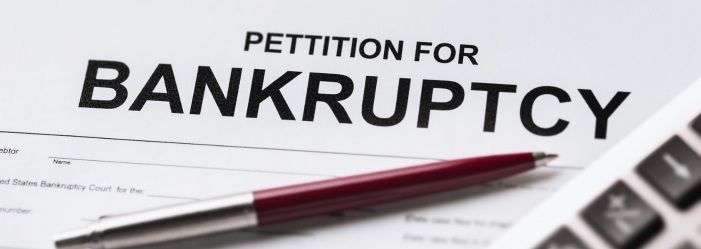Last Updated: March 25, 2024
Your Guide on Filling Bankruptcy

Disclaimer: We are not qualified legal or tax professionals and are not giving advice. Always speak with a qualified professional before making any legal or financial decisions.
Faced with California's soaring cost of living, an increasing number of residents are considering bankruptcy as a path to financial relief.
Understanding both federal law and California-specific exemptions is crucial in navigating your options, whether you're facing job loss, medical bills, or overwhelming debt.
This guide outlines the steps to file for bankruptcy in California, helping you choose the right chapter and protect your assets in the process.
Ready to talk now? Connect with a debt specialist instantly for a free consultation.
What is bankruptcy?
Bankruptcy is a legal status that will discharge all of the debtor's debts. Bankruptcy can be done by the individual or business if they have an inability to pay their debts.
It is one way to eliminate some of your debt and get back on your feet, but it does come with consequences. The best thing you can do before filing for bankruptcy is learning as much about it as possible so you know what steps are taken after filing for bankruptcy.
Timing can be everything when it comes to filing for bankruptcy. Learn more about the best time to file a bankruptcy in this detailed article here.
Chapter 7 Bankruptcy
Chapter 7 bankruptcy is a full discharge of your debts, released back to the creditor. After this complete discharge, you can no longer be contacted and pursued about those debts by the creditors.
Chapter 7 bankruptcy releases all types of unsecured debt such as credit card balances and medical bills with the exclusion of certain taxes, student loans, most government debt (such as child support), family court judgments related to child or spousal support or damage payments for physical injury ect.
Chapter 11 Bankruptcy
Chapter 11 bankruptcy is a form of bankruptcy for individuals, corporations, or partnerships that allows these entities to reorganize their debts under the protection of the bankruptcy court. Chapter 11 proceedings allow the debtor to propose a plan to repay all or part of its debts to its creditors over time, subject to court approval. In contrast Chapter 7 typically results in liquidation but unlike other types of personal bankruptcies it can be used for both individuals and businesses alike.
In addition, when a company completes a chapter 11 reorganization they will need at least one year before they can re-file under chapter 11 again however if you have considerable equity and your dischargeable debt decreases during this period.
Chapter 13 Bankruptcy
Chapter 13 Applies to Individual Filers and Families. If you are an individual under the age of 18 or your present income is insufficient, Chapter 7 will be more appropriate.
However, if you have regular income such as a salary or hourly wage and can afford to make payments toward your debts for three years in a court supervised repayment plan with adequate documentation that shows ability to complete those payments, then Chapter 13 is perfect.
In Chapter 13 bankruptcy, instead of liquidation like in Chapter 7 bankruptcy, debtors propose a repayment plan by submitting documents detailing their income and living expenses along with their list of creditors so the bankruptcy court may decide if the proposed payment plan is fair for all involved parties.
Chapter 13 Bankruptcy on the other hand, is a bit more complex. For a better understanding of how Chapter 13 works, you can read more about the bankruptcy basics.
How Does California Bankruptcy Work?
The first thing to know about filing for Chapter 7 Bankruptcy in California is that it requires liquidating nonexempt property in order to pay creditors. If there isn't enough nonexempt assets or equity in a property for a debtor's debts, then he or she must file under another chapter of the Bankruptcy Code (i.e., Chapter 13).
The bankruptcy court discharges these debts at an individual’s request through either Chapter 13 (adjustment of debts) or Chapter 11 (reorganization).
Click for more detailed information on California debt relief and bankruptcy. A discharge means that you no longer have a financial obligation on those discharged debts; any repayment agreement is canceled.
What this does not mean: You are still liable for what has been excused under your bankruptcy filing — it merely cancels future liability related to those particular obligations if they come back into play down the road.
The Main Bankruptcy Forms You'll Need to Fill Out
In the U.S., bankruptcy is a process that allows people with too much debt to get out of it and start over again. The first step in this process is filing for Chapter 7 or 13 bankruptcy protection.
You'll need to fill out different forms depending on which type of bankruptcy you're filing for, but here are the main ones:
- Petition and Schedule A;
- Schedules B-J;
- Statement of Financial Affairs Trustee Certification Form;
- Notice of Hearing (Chapter 7);
- Declaration Under Penalty Of Perjury For Individual Debtor (Chapter 7);
- Listing Of Creditors Holding Secured Claims (Chapter 7). These documents will help you file your petition in court so you can get the legal protections you need to start rebuilding your life.
How do I file for bankruptcy in California?
If you live in California you'll need to file for Chapter 7 or 13 bankruptcy with your local U.S. Bankruptcy Court. You need to fill out an application and submit all the required documentation such as financial statements, tax returns, pay stubs, and more before the court can approve your petition for filing either Chapter 7 or 13 bankruptcy.
Once approved by the court, you'll be given a date when they will review your petition at a hearing which will usually take place within two weeks of submitting it if no objections have been filed against it beforehand.
Am I eligible to file for bankruptcy in California?
What makes you eligible for bankruptcy in the state of California? That is an important question. The state of California has unique rules about who can file for bankruptcy. It is important to know these before you decide if it is the right option for your situation.
You are eligible to file for bankruptcy in the state of California if:
- You have a total income that is less than your monthly expenses and you cannot pay back any debts within five years.
- Your debts are primarily consumer-related, not business or commercial as these will be excluded from eligibility.
- You have at least $250 in nonexempt assets.
- One of the following conditions exists: you are disabled, a veteran filing for disability benefits, or if your income is below 125% of the federal poverty level and there will be an undue hardship to others if you pay back any debts within five years.
The benefits and consequences of filing for bankruptcy in California
If you have been struggling with debt and are uncertain about how to get out of it, filing for bankruptcy may be the solution. But before you make a decision, it's important to consider both the benefits and consequences of this action.
Before deciding on bankruptcy, it’s worth
exploring bankruptcy alternatives like debt settlement. You might want to consider using a debt relief program, and you can learn why.
The benefits of filing bankruptcy in California to secure assets includes protecting your home from being foreclosed on, protecting personal property, avoiding income tax liens, settling all other unsecured obligations, discharge (get rid) past truant debt that will no longer appear as unpaid account balances if you apply for credit again in the future - thereby preserving access to new credit with decent interest rates; it also prevents an automatic stay from being lifted by a court so you can continue to work and make payments on your debts.
The consequences of filing for bankruptcy in California are that a bad credit rating will be recorded as bankruptcy for seven years, you are not eligible for government benefits such as student loans and unemployment compensation, there is a three to five year waiting period before you can apply to be reinstated as a debtor, and your assets will become part of the bankruptcy estate.
Who can help me with my case if I decide to file for bankruptcy in California?
Filing for bankruptcy will protect you from creditors. It can also help lower your monthly payments. To file and the courts, you'll need to get an attorney to assist you- follow this link for more info on how to find one in California.
Be aware that filing for bankruptcy does bring with it significant obstacles and risks. You'll want as much information as possible before making a decision about your situation, including what kinds of debt relief options there are (including debt settlement).
Is Debt Settlement Better Than Bankruptcy?
That's impossible to answer because everyone's financial situation is different, there’s no right or wrong answer. We suggest you look into both options thoroughly to find out which one better meets your needs.
Bankruptcy usually wipes all your debt clean and creates a fresh slate. Debt settlement usually either decreases the amount of your monthly payments, or gives you more time to pay off your balances, but does not wipe the debt clean.
In order for bankruptcy to eliminate someone's debts, often referred to as Chapter 7 bankruptcy in most states (except Iowa which requires repayment of unsecured bad loans), the person must pass both tests: means test and disposable income test.
For those that are unable to meet these two tests, you may be eligible for Chapter 13 bankruptcy. Debt Settlement can help reduce monthly bills. A debtor pays out the agreed-upon sum over a fixed period of time, typically three years or five years depending on the creditor and your situation.
Who Can Explain How Debt Settlement Works?
Pacific Debt has been helping people get out of debt since 2002. They pride themselves on being the most consumer-friendly company for providing credit card, personal loan, and other types of consumer-generated debts in order to make your life a little less stressful.
Pacific Debt Inc
helps people who need help dealing with their high-interest rates when it comes to credit cards or any type of loans they may have incurred. Pacific Debt provides you support during this difficult time by eliminating whatever worries there are about what's next while also giving them the opportunity at saving thousands.
Debt Settlement vs. Bankruptcy
Filing for bankruptcy or pursuing debt settlement both allow you to resolve unmanageable debt, but they work differently.
Cost
The court filing fee for Chapter 7 bankruptcy is $338, while attorney fees range from $1,500-$2,500. The total cost is usually $2,000-$3,000. Debt settlement programs typically charge 15-25% of your enrolled debt, so costs depend on your total debt amount.
Impact on Credit
Bankruptcy is detrimental to your credit with a bankruptcy notation for 10 years. With debt settlement, negatives remain on your credit report for 7 years, but won't have the bankruptcy designation.
Asset Protection
In Chapter 7 bankruptcy, some assets may be sold to pay creditors. You can keep certain exempt assets like a home, car, and personal items. With debt settlement, you keep all property.
Timeframe
The bankruptcy process typically takes 3-6 months. A debt settlement program usually takes 2-4 years to complete because accounts must be settled one by one.
Qualification
Bankruptcy qualification depends on passing a means test. Debt settlement programs usually require unsecured debts over $7,500-$10,000.
Finding a Bankruptcy Attorney
When meeting with bankruptcy attorney prospects, ask questions like:
- How long have you practiced bankruptcy law? Look for 5+ years experience.
- How much do you charge for Chapter 7 cases, and what is included? Avoid attorneys charging significantly above state averages.
- How responsive are you to client inquiries and keeping clients updated? Ensure you’ll get good communication.
Watch out for attorneys who won’t provide a flat fee quote, try to push you into Chapter 13 unnecessarily, or make guarantees about completely eliminating student loans or back taxes. These are red flags. Average attorney fees for Chapter 7 range from $1,500-$2,500 in California.
Consider this Checklist
Documents Needed to File for Bankruptcy:
- Last 2 years of federal tax returns
- 6 months of pay stubs
- Last 2 months of bank statements
- Retirement account statements
- Mortgage statements
- Vehicle title(s)
- Last 2 months statements for all debts
- Government-issued ID
- Social Security card
- Certificate of credit counseling course completion
- Vehicle valuation estimate
- Home valuation estimate
FAQs
Conclusion
If you're struggling to make payments or want to get out of debt and don't know where to turn, contact us today so we can consult with you on the best ways to proceed!
Our California debt relief reviews are available online for your convenience. Take a look through them and see what other people have to say about the services we offer, or feel free to leave us feedback yourself!
*Disclaimer: Pacific Debt Relief explicitly states that it is not a credit repair organization, and its program does not aim to improve individuals' credit scores. The information provided here is intended solely for educational purposes, aiding consumers in making informed decisions regarding credit and debt matters. The content does not constitute legal or financial advice. Pacific Debt Relief strongly advises individuals to seek the counsel of qualified professionals before undertaking any legal or financial actions.
✔ Accredited by Better Business Bureau with BBB A+ rating (4.93 rating and 1678 reviews)
✔ US News and World Reports and Bankrate ranked Pacific Debt Relief as one of “The Best Debt Relief Companies of 2024”
✔ 6.9 star rating by BestCompany.com (over 2379 client reviews)
✔ 4.8 star rating by TrustPilot based (over 1613 verified consumer reviews)
✔ ConsumerAffairs.com Accredited (over 544 verified reviews with an average rating of 5 stars)
✔ A Top 10 Rated Compan by TopTenReviews.com , ConsumersAdvocate.com and Top10debtconsolidation.com
✔ 4.6 star rating by Google (229 client reviews)
✔ 100% rating by SuperMoney (9 client reviews)
Reduce Your Credit Card Debt By Up to Half

BBB Reviews | 4.9/5.0 Rating









 Do Not Sell My Personal Information
Do Not Sell My Personal Information